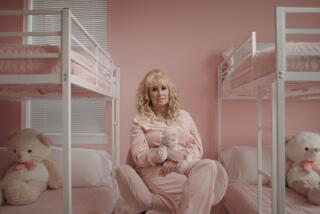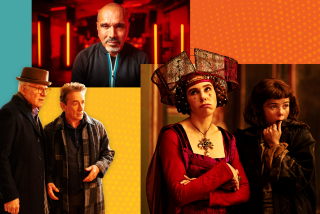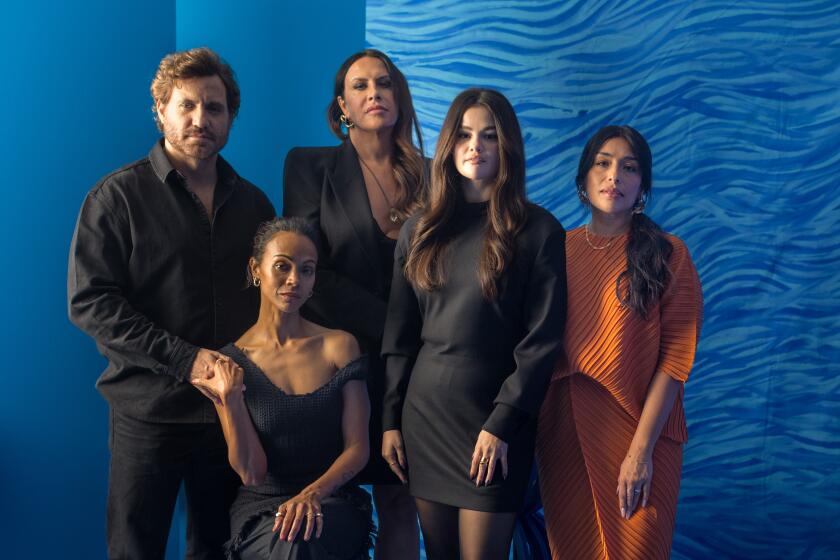‘Game of Thrones’ in the wild: BBC America’s ‘Dynasties’ explores battle for power
In the early-morning darkness of Mana Pools National Park in Zimbabwe, two safari vehicles are on the hunt for a pack of painted wolves. It’s a dramatic sequence that’s part of BBC America’s new nature series “Dynasties.”
The series, narrated by David Attenborough, focuses on five species, one of which is a small, dog-like wolf dappled in multicolored spots and patches. There are around 6,000 painted wolves left in the world, with only 100 in Mana Pools, and the animals are proving extremely difficult to find.
Wildlife guide Nick Murray, who owns Bushlife Safaris with his wife, Des, is leading the hunt, circling with a radio antenna that will hopefully ping the location of the pack. As the sun rises over the dusty landscape, the wolves appear, casually sprawled in the dirt.
“The biggest challenge was finding them,” explains Nick Lyon, who directed and produced the painted wolf episode of “Dynasties.” “This morning was massively lucky. It’s been very rare for anyone to spend this much time with the painted wolf. This was the episode they thought could fail.”
The entire premise of “Dynasties” — the five-episode series premieres on Saturday also on the AMC, IFC and Sundance networks — was a gamble. When Mike Gunton, creative director of the BBC Natural History Unit and executive producer of “Dynasties,” conceived of the idea he was aware that the concept of tracking one group of animals for several years had the potential to fail completely. His idea was to make a nature series that had the narrative arc of a drama — think “Game of Thrones” in the wild.
“I’ve worked on a lot of these BBC landmark programs, like ‘Planet Earth II,’ and they have a particular form to them,” Gunton says. “We’ve done a lot of those, but every time we do that I come away thinking, ‘There’s so much story to tell about that animal.’ In those other shows essentially what we show is their party trick, whereas the complexity of their lives and their struggles – we never show that side of the story. I thought, ‘Could we do that?’
“The challenge, of course, is that it’s very risky because you’re putting all your eggs in one basket. If it all goes wrong you spent an enormous amount of time and an enormous amount of money and you’ve got nothing.”
Selecting the right five species was paramount. Each one in the episodes — which get up close and personal with chimpanzees, lions, emperor penguins, painted wolves and tigers — is endangered and being studied by animal scientists and researchers. That meant that the filmmakers could select a group of lions or chimps that were already familiar to the researchers. The painted wolves in Mana Pools, for instance, had been followed by Murray for over 25 years, meaning that Lyon and his team had a strong background on the packs.
“We needed a situation where the animals’ history was known so we knew both the individuals and their back story, the politics going on in their family lives before we turned up,” Gunton says. “What we were looking for was a moment when we could be sure something dramatic was going to happen: a takeover, a conflict between a mother and daughter or a battle for power. This show really is about family, but it’s also about the battle for power within the family.”
Despite extensive background knowledge, it was impossible to predict how the stories would actually unfold during shooting. Lyon spent two years on and off in Mana Pools following two feuding packs, capturing 320 hours of footage, while Rosie Thomas, director and producer of the chimpanzees episode, followed a particular chimp named David through the wilds of Senegal, clocking more than 1,500 miles throughout filming.
“It was filming for two years with these groups where we really didn’t know what was going to happen, and for me that was exciting,” Thomas says. “What we set out to do was show the reality of what life is like for those animals and nothing could have happened. But it was just a remarkable story. And this chimp was the most extraordinary character – you could just see it in him, this resilience and this determination and this strength.”
‘Well, they made it up because they got a lot of footage from different creatures and then manufactured the story.’ In fact, that is absolutely not the case.
— David Attenborough
She adds, “So often nature shows just drop into these worlds and show little snippets of behaviors, these little five-minute sequences, but being able to see how their lives actually play out over such a long period of time is important. Understanding these animals better helps people care about them more.”
Even Attenborough, who has worked with the BBC since the 1950s, was surprised by the revelations generated by following one specific animal so closely — particularly the lions episode, which tracks the Marsh pride in Kenya’s Masai Mara National Reserve.
“Our tendency when looking at these sorts of programs is to say, ‘Well, they made it up because they got a lot of footage from different creatures and then manufactured the story,’” Attenborough notes. “In fact, that is absolutely not the case. These were real stories and you could tell they were real stories because they didn’t go the way you thought they were going to go.”
The primary intent of “Dynasties” is to engage and entertain viewers, immersing them in the day-to-day existence of specific animals. But the series also has the potential to draw attention to powerful environmental issues. The human threat to each species is apparent throughout, and Attenborough pointedly references the menace of climate change at the end of the penguin episode.
Seeing the tangible impact of our actions on nature can lead to actual change, as shown by the response to “Blue Planet II,” which aired in 2017. The premiere episode was the most-watched nature program on ad-supported TV in Britain in eight years and drew nearly 3 million viewers in a five-network simulcast that included BBC America and AMC. Images of animals and plastic resonated strongly, causing viewers (including Queen Elizabeth) to commit to less plastic use.
“For some reason or another it has just a hit a nerve in the viewing public’s imagination or consciousness,” Attenborough says. “There’s never been such a widespread reaction. Seeing a mother albatross coming back after a fortnight away looking for her food for her chick and then to see what comes out of her beak when she regurgitates her food – it’s not fish, it’s all plastic. A shot like that has such evocative power that I’m not surprised that it caused a big effect.”
If there was ever a time to remind people of the importance of preserving the natural world it would be now. Attenborough recently spoke at the U.N. climate change summit in Poland and hopes to be a voice for the planet as the very real threat of climate change becomes more and more immediate for humans and animals alike.
“All of us are making these kinds of shows because we are fascinated by the natural world,” says Attenborough. “And if you’re fascinated by the natural world you have to know that it’s in imminent and grave danger in the biggest crisis that’s faced humanity for a very, very long time. How can you sit on your hands and think you’re just going to tell fairy stories?”
------------
‘Dynasties’
Where: AMC, BBC America, IFC, Sundance
When: 9 p.m. Saturday
Rated: TV-G (suitable for all ages)
More to Read
Only good movies
Get the Indie Focus newsletter, Mark Olsen's weekly guide to the world of cinema.
You may occasionally receive promotional content from the Los Angeles Times.










